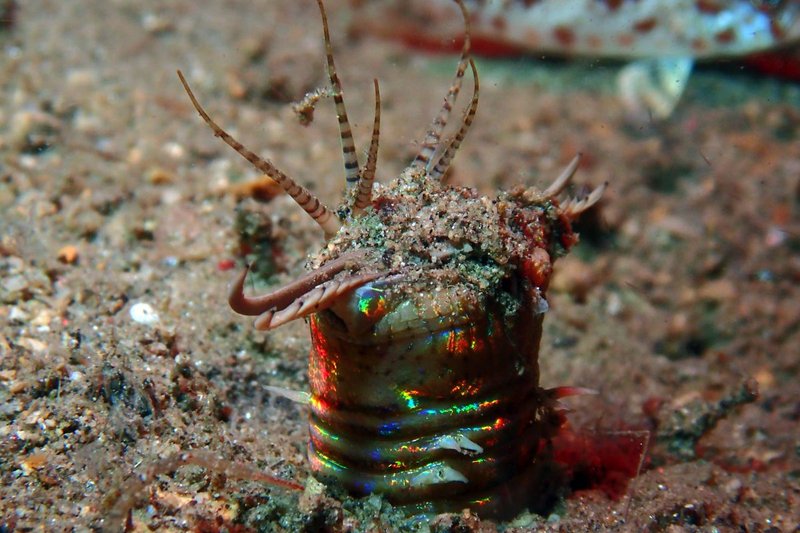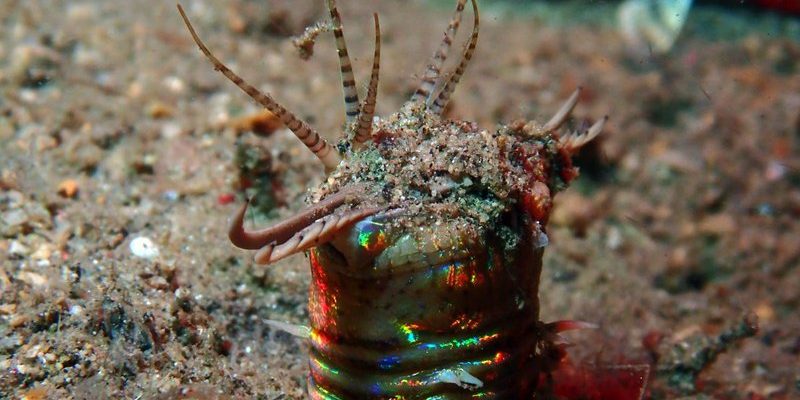
Bobbit worms have a unique and somewhat gruesome feeding strategy. They’re not just passive creatures waiting for food to come to them; rather, they are skilled hunters, striking quickly when prey swims by. In this article, we’ll explore how often Bobbit worms eat in the wild, their hunting methods, and what their diet consists of. So grab your favorite drink, sit back, and let’s dive into the world of these intriguing marine hunters.
The Bobbit Worm: An Overview
The **Bobbit worm**, belonging to the Eunicidae family, is mostly found in tropical and subtropical oceans. Its scientific name, *Eunice aphroditois*, is a bit of a mouthful, but you can think of it as the ocean’s version of a stealthy ambush predator. These worms can grow up to 10 feet long and have a body made of numerous segments, each contributing to their surprising agility.
A Bobbit worm has a set of specialized **jaws** that can snap shut at lightning speed. When prey, like small fish or crustaceans, comes close, the worm strikes with precision. Just picture a ninja waiting patiently before launching into action—that’s a Bobbit worm for you! Amazing, right? But let’s not get too sidetracked. The main question is: how often do they eat in the wild?
How Often Do Bobbit Worms Eat?
Bobbit worms do not have a rigid eating schedule, but they typically feast on whatever comes their way, which can be several times a **week**. Unlike some predators that hunt daily or have specific feeding times, Bobbit worms can go days without eating, especially if they’re in a low-activity phase or if food is scarce.
Predation is often opportunistic for these creatures. They might eat once every few days, depending on the availability of food. For instance, if the water is teeming with small fish or shrimp, the worms might eat more frequently. Conversely, in a less populated area, they might wait longer between meals.
One interesting aspect of their eating habits is their ability to store energy. Bobbit worms can consume a large meal and then rely on that energy for several days, which plays a vital role in their survival.
What Do Bobbit Worms Eat?
Bobbit worms are carnivorous and have a rather varied diet. They primarily feed on:
- **Small fish**: These are often the main course for a Bobbit worm.
- **Crustaceans**: Shrimp and crabs are also on the menu.
- **Other marine invertebrates**: They won’t shy away from other smaller creatures in their environment.
Using their powerful jaws, Bobbit worms can also capture prey larger than themselves, making them formidable hunters. It’s like when you find that one food item you absolutely crave, and you just can’t get enough; that’s how these worms approach their meals. Here’s the thing: their feeding behavior is not just about survival; it also plays a vital role in maintaining the balance of their ecosystem.
Hunting Techniques
Bobbit worms are masters at ambush hunting. Their strategy is all about patience. They bury themselves in the ocean floor, leaving only their **fringed head** visible. This makes it difficult for prey to see them. When something edible swims by, the worm strikes with incredible speed.
Once they catch their prey, they pull it down into their burrow, where they can consume it safely. This process is quite efficient, and their **camouflage** helps them remain undetected until the perfect moment to strike. It’s like being at a buffet and suddenly spotting the dish you’ve been waiting for; the thrill of the chase is what keeps them excited!
Impact of Environmental Factors
The frequency with which Bobbit worms eat can vary based on **environmental factors**. For example, water temperature, food availability, and habitat conditions all play a role in their feeding behavior. Warmer water temperatures can increase the activity levels of both the Bobbit worm and its prey, possibly allowing for more frequent meals.
Moreover, in areas where food is abundant, like coral reefs, Bobbit worms might eat more often. However, in less fruitful regions, they might have to go longer between meals. Just imagine trying to find food in a barren landscape versus a bustling market; it’s a big difference in how often you get to eat!
Potential Challenges in the Wild
Every creature faces challenges, and Bobbit worms are no different. Their ability to eat and thrive can be affected by various factors:
- **Predation**: Larger fish or other predators may hunt Bobbit worms.
- **Habitat destruction**: Human activities, like pollution and overfishing, can disrupt their natural habitats.
- **Climate change**: Altered water temperatures and ocean conditions can affect their food sources and overall health.
These challenges can lead to fluctuations in their eating frequency, which ultimately impacts their survival and the health of their ecosystems.
Bobbit worms are fascinating creatures with remarkable adaptations for survival. While they may eat every few days, their eating habits are influenced by environmental conditions and food availability. Their unique hunting abilities make them skilled predators in the ocean’s depths.
Understanding how often Bobbit worms eat not only enriches our knowledge of these creatures but also highlights the importance of preserving their habitats. Just like every meal counts for us, it matters for them too. So, the next time you think about the ocean, remember the Bobbit worm, a skilled hunter quietly contributing to the balance of marine life.

